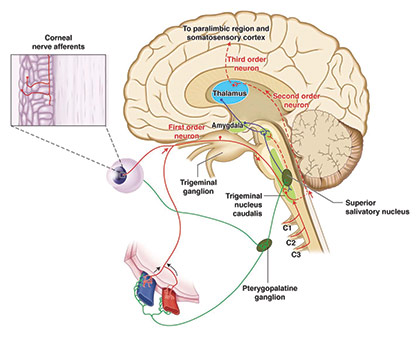By Deborah Kotob, ABOM
Trigeminal dysphoria—wait, what? I admit the first time I heard the words trigeminal dysphoria, I was both intimidated and intrigued. (And yes, I had to practice its pronunciation!)
Let me give an example of trigeminal dysphoria that we can all relate too—brain freeze! This sharp headache occurs when there is a sudden change in temperature when we drink or eat something cold like ice cream, which excites the neural feedback loop to the trigeminal nerve and causes the sensation of pain. What does this have to do with eyes?
There is an ophthalmic branch of the trigeminal nerve (Fig. 1). When overstimulated, visually induced trigeminal dysphoria symptoms occur. The symptoms consist of digital eyestrain, headache, neck and shoulder pain. Additionally, the patient often feels eye irritation that feels like dry eyes even if no physical evidence of dry eye is evident.
The trigeminal nerve relays signals regarding the position of each eye through its ophthalmic branch. The purpose of this neural information is to avoid binocular misalignments of the eyes. These neural transmissions also influence the ability to detect sensation and pain.
EFFECTS OF DIGITAL DEVICE USE TRIGGERS THE PAIN OF TRIGEMINAL DYSPHORIA
Visually induced trigeminal dysphoria results from eye misalignments. In 90 percent of people who experience trigeminal dysphoria, they demonstrate greater misalignment when looking at near versus far. It is their regular sustained use of near vision while reading digital device screens that is a powerful trigger for the pain and other symptoms of trigeminal dysphoria. In an attempt to compensate for the misalignment of the eyes, the visual system becomes overworked and strained, leading to trigeminal nerve overstimulation and the uncomfortable symptoms of trigeminal dysphoria.
You may be among those of us who experience digital eyestrain symptoms who have not realized complete relief from the recommended 20-20-20 rule or blue light filters or even lenses that address accommodative lag. So what gives? Why do some find relief while others still suffer? We may be experiencing a mismatch between the proprioceptive (self-movement and body position) feedback loop/trigeminal nerve and our eyes! The result is overstimulation (think brain freeze), leading to pain and discomfort symptoms.

FIG. 1 The trigeminal nerve ophthalmic branch sends sensations from your brain to your head, eyes, neck, and shoulders
The subtlety of the misalignment and the fact that it does not result in a loss of binocularity made these conditions difficult to detect, until now. Now thanks to Neurolens, Inc., the disorder can be measured and effectively treated in most instances. Neurolens, Inc.’s Measurement Device uses advanced eye-tracking technology to accurately measure the degree of ocular misalignment at near and distance. Start to finish, the precise measurements take three minutes (over 10,000 data points taken). To treat visually induced trigeminal dysphoria, Neurolens, Inc., introduced the unique neurolens, a lens that incorporates a customized contoured prism to coordinate the alignment of the eyes at all distances. Until now, eye and brain connection to trigeminal dysphoria was not fully understood. Standard treatment included a small amount of prism added to prescription lenses in hopes of improving visual comfort for some patients. But this only resolved eye misalignment at a single distance. To correctly treat the visually induced trigeminal dysphoria, the misalignment had to be corrected in all distances. Neurolenses are customizable contoured prism lenses that gradually increase the prism from distance to near, thereby providing eye alignment at all points.
A sentence struck me in the CE article referenced below: It reads, “Now more than ever before, there is the need to create the most ‘comfortable’ vision and not just clear vision.” We have to go beyond correcting ametropia for clear vision and consider the entire visual experience, which must include COMFORT, both visual and physical! I am grateful to innovative companies like Neurolens, Inc., who pioneer solutions that improve our vision and our life. I am also thankful for their generous sponsorship of continuing education. I hope I have piqued your interest and that you will read the free ABO CE sponsored by Neurolens, Inc., in the May issue of 20/20 and at 2020mag.com, “Neurolens: A Breakthrough Solution for Headaches, Neck Tension and Digital Eyestrain."













